ESP OLDSMOBILE SILHOUETTE 1995 Owners Manual
[x] Cancel search | Manufacturer: OLDSMOBILE, Model Year: 1995, Model line: SILHOUETTE, Model: OLDSMOBILE SILHOUETTE 1995Pages: 390, PDF Size: 20.27 MB
Page 27 of 390

Here Are Questions Many People Ask
About Safety
Belts -- and the Answers
&= Won’t I be trapped in the vehicle after an
accident if I’m wearing a safety belt?
A: You could be -- whether you’re wearing a safety
belt or not. But you can unbuckle a safety belt,
even
if you’re upside down. And your chance of
being conscious during and after an accident,
so
you can unbuckle and get out, is much greater if
you are belted.
Why don’t they just put in air bags so people
won’t have to wear safety belts?
A: Air bags are in many vehicles today and will be in
more
of them in the future. But they are
supplemental systems only;
so they work with
safety belts -- not instead of them. Every air bag
system ever offered for sale has required the use of
safety belts. Even if you’re in
a vehicle that has air
bags, you still have to buckle
up to get the most
protection. That’s true not only
in frontal collisions,
but especially in side and other collisions.
@ If I’m a good driver, and I never drive far from
home, why should
I wear safety belts?
A: You may be an excellent driver, but if you’re in an
accident
-- even one that isn’t your fault -- you and
your passengers can be
hurt. Being a good driver
doesn’t protect you from things beyond your
control, such as bad drivers.
Most accidents occur within
25 miles (40 km) of
home. And the greatest number of serious injuries
and deaths occur at speeds
of less than 40 mph
(65 kmh).
Safety belts are for everyone.
1-17
ProCarManuals.com
Page 91 of 390
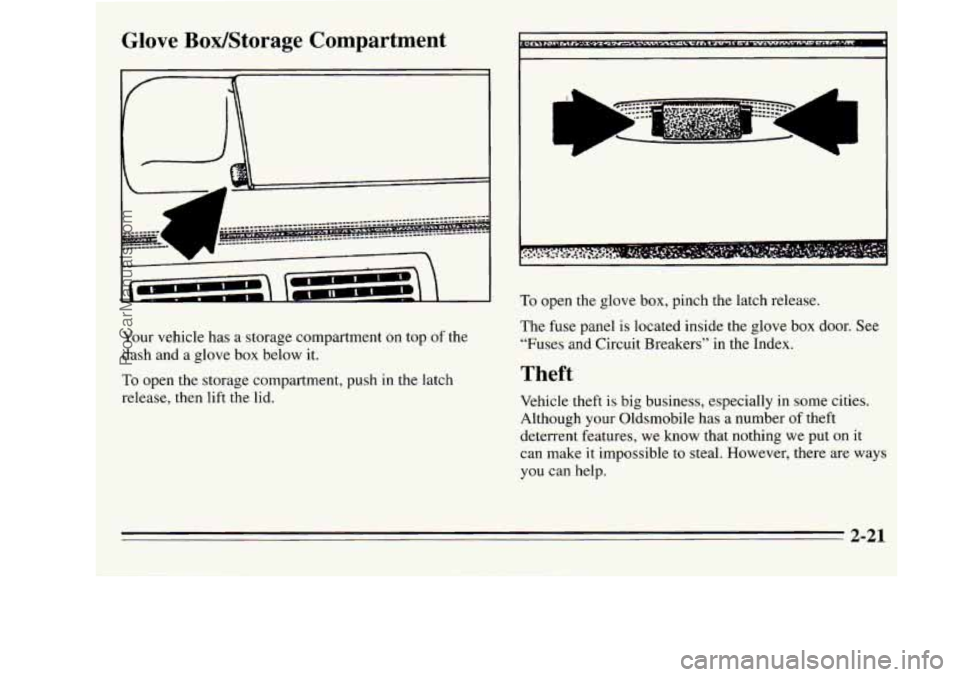
Glove Bodstorage Compartment
Your vehicle has a storage compartment on top of the
dash and a glove box below it.
To open the storage compartment, push in the latch
release, then
lift the lid.
r
To open the glove box, pinch the latch release.
The fuse panel
is located inside the glove box door. See
“Fuses and Circuit Breakers” in the Index.
Theft
Vehicle theft is big business, especially in some cities.
Although your Oldsmobile has a number of theft
deterrent features, we know that nothing we put on it
can make
it impossible to steal. However, there are ways
you can help.
2-21
ProCarManuals.com
Page 179 of 390
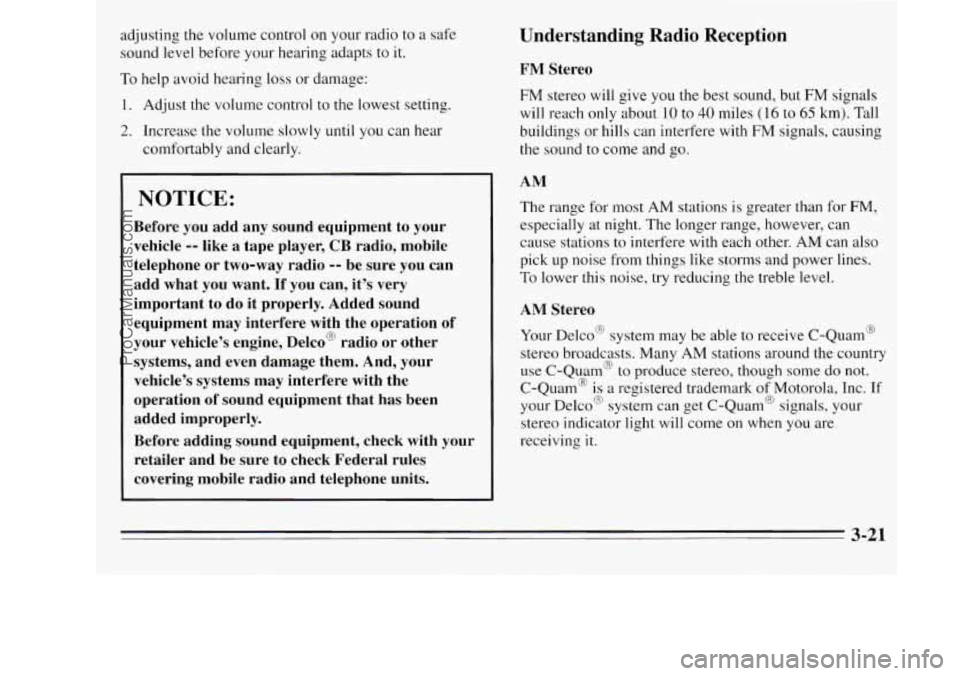
adjusting the volume control on your radio to a safe
sound level before your hearing adapts to
it.
To help avoid hearing loss or damage:
1. Adjust the volume control
to the lowest setting.
2. Increase the volume slowly until you can hear
comfortably and clearly.
I NOTICE:
Before you add any sound equipment to your
vehicle
-- like a tape player, CB radio, mobile
telephone or two-way radio
-- be sure you can
add what you want.
If you can, it’s very
important to do it properly. Added sound equipment may interfere with the operation of
your vehicle’s engine, Delco@ radio
or other
systems, and even damage them. And, your
vehicle’s systems may interfere with the
operation
of sound equipment that has been
added improperly.
Before adding sound equipment, check with your retailer and be sure to check Federal rules
covering mobile radio and telephone units.
Understanding Radio Reception
FM Stereo
FM stereo will give you the best sound, but FM signals
will reach
only about 10 to 40 miles ( 16 to 65 km). Tall
buildings or hills can interfere with
FM signals, causing
the sound
to come and go.
AM The range for most AM stations is greater than for
FM,
especially at night. The longer range, however, can
cause stations to interfere with each other. AM can
also
pick up noise from things like storms and power lines.
To lower this noise, try reducing the treble level.
AM Stereo
Your Delco@ system may be able
to receive C-Quam@
stereo broadcasts. Many AM stations around the country
use C-Quam@
to produce stereo, though some do not.
C-Quam@ is a registered trademark of Motorola, Inc. If
your Delco@ system can get C-Quam@ signals, your
stereo indicator light will come on when
you are
receiving
it.
3-21
ProCarManuals.com
Page 186 of 390

The body takes about an hour to rid itself of the alcohol
in one
drink. No amount of coffee or number of cold
showers will speed that up.
“I’ll be careful” isn’t the
right answer. What if there’s an emergency, a need to
take sudden action, as when a child darts into the street?
A person with even a moderate BAC might not be able
to react quickly enough to avoid the collision.
There’s something else about drinking and driving that
many people don’t know. Medical research shows that
alcohol in a person’s system can make crash injuries
worse, especially injuries to the brain, spinal cord or
heart. This means that when anyone who has been
drinking
-- driver or passenger -- is in a crash, that
person’s chance of being killed or permanently disabled
is higher than
if the person had not been drinking.
4-4
ProCarManuals.com
Page 191 of 390
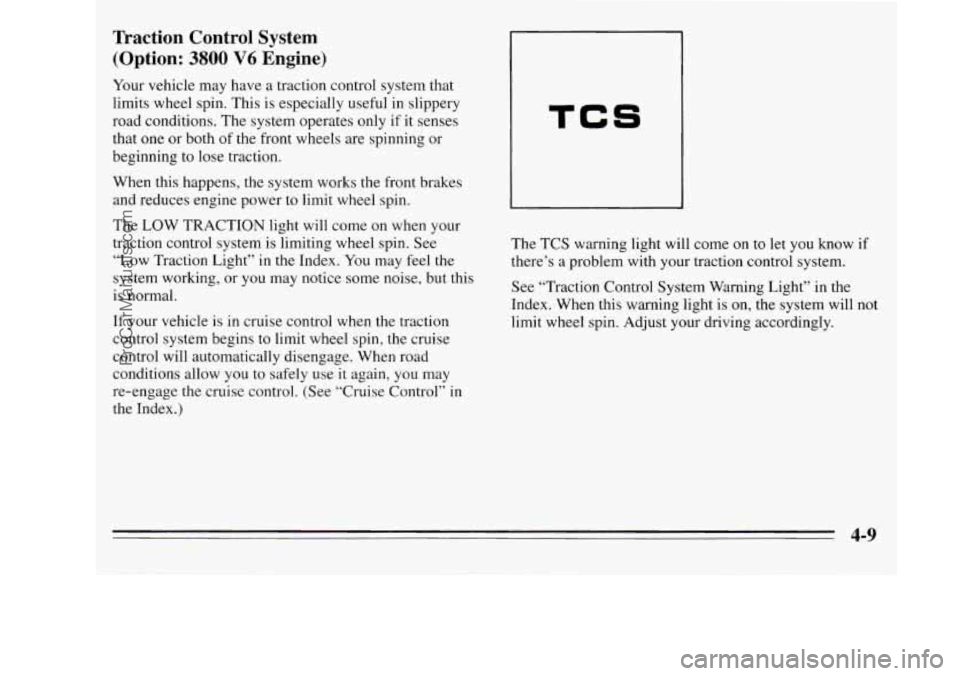
Traction Control System
(Option:
3800 V6 Engine)
Your vehicle may have a traction control system that
limits wheel spin. This is especially useful in slippery
road conditions. The system operates only if it senses
that one or both of the front wheels are spinning or
beginning to lose traction.
When this happens, the system works the front brakes
and reduces engine power to limit wheel spin.
The LOW TRACTION light will come on when your
traction control system is limiting wheel spin. See
“Low Traction Light” in the Index. You may feel the
system working, or you may notice some noise, but this
is normal.
If your vehicle is in cruise control when the traction
control system begins to limit wheel spin, the cruise
control will automatically disengage. When road
conditions allow you
to safely use it again, you may
re-engage the cruise control. (See “Cruise Control” in
the Index.)
TCS
The TCS warning light will come on to let you know if
there’s a problem with your traction control system.
See “Traction Control System Warning Light’’ in the
Index. When this warning light is on, the system will not
limit wheel spin. Adjust your driving accordingly.
4-9
ProCarManuals.com
Page 192 of 390
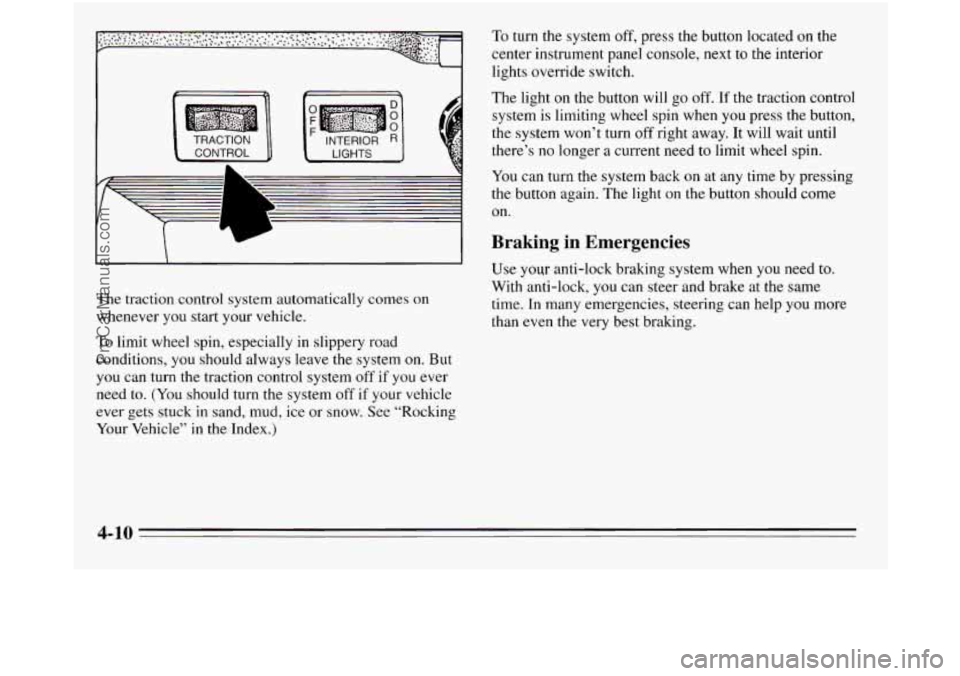
The light on the button will go off. If the traction control
system is limiting wheel spin when you press the button,
the system won’t turn
off right away. It will wait until
there’s no longer a current need to limit wheel spin.
You can turn the system back on at any time by pressing
the button again. The light on the button should come
on.
Braking in Emergencies
I I I Use your anti-lock braking system when you need to.
With anti-lock,
you can steer and brake at the same
time. In many emergencies, steering can help you more
than even the very best braking.
The
traction control system automatically comes
on
whenever you start your vehicle.
To limit wheel spin, especially in slippery road
conditions,
you should always leave the system on. But
you can turn the traction control system off if you ever
need to.
(You should turn the system off if your vehicle
ever gets stuck
in sand, mud, ice or snow. See “Rocking
Your Vehicle” in the Index.)
4-10
ProCarManuals.com
Page 195 of 390
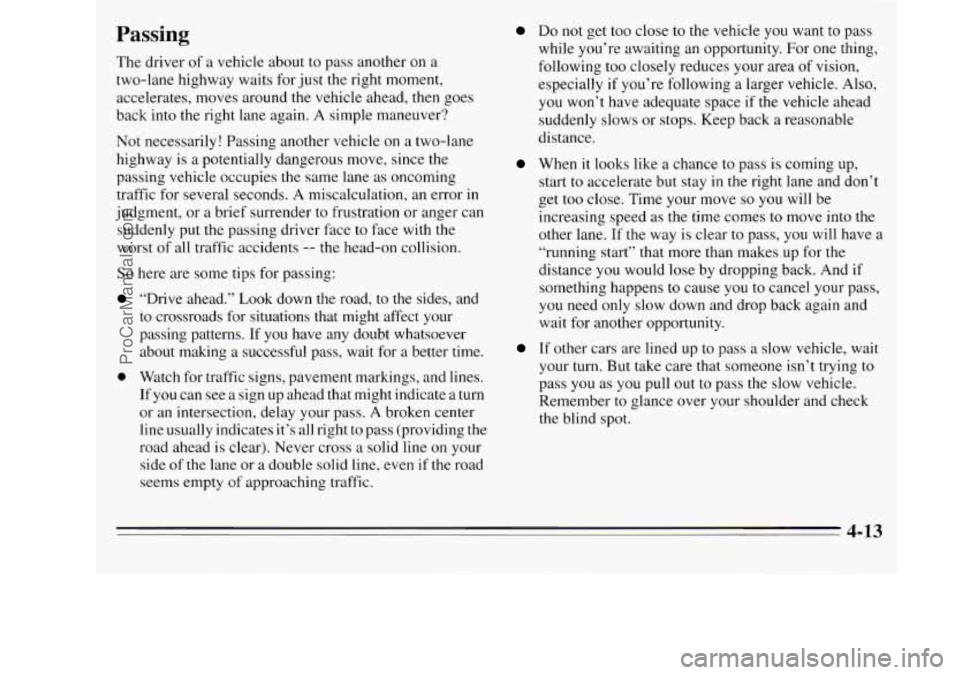
Passing
The driver of a vehicle about to pass another on a
two-lane highway waits for just the right moment,
accelerates, moves around the vehicle ahead, then goes
back into
the right lane again. A simple maneuver?
Not necessarily! Passing another vehicle on a two-lane
highway
is a potentially dangerous move, since the
passing vehicle occupies
the same lane as oncoming
traffic for several seconds.
A miscalculation, an error in
judgment, or a brief surrender to frustration or anger can
suddenly put the passing driver face to face with the
worst
of all traffic accidents -- the head-on collision.
So here are some tips for passing:
“Drive ahead.” Look down the road, to the sides, and
to crossroads for situations that might affect your
passing patterns. If you have any doubt whatsoever
about making a successful pass, wait for a better time.
0 Watch for traffic signs, pavement markings, and lines.
If you can see a sign up ahead that might indicate
a turn
or an intersection, delay your pass. A broken center
line usually indicates it’s all right to pass (providing the
road ahead is clear). Never cross a solid line on your
side
of the lane or a double solid line, even if the road
seems empty
of approaching traffic.
Do not get too close to the vehicle you want to pass
while you’re awaiting an opportunity. For one thing,
following too closely reduces your area of vision,
especially if you’re following a larger vehicle. Also,
you won’t have adequate space if the vehicle ahead
suddenly slows or stops. Keep back a reasonable
distance.
When it looks like a chance to pass is coming up,
start
to accelerate but stay in the right lane and don’t
get
too close. Time your move so you will be
increasing speed as the time comes to move into the
other lane. If the way is clear to pass, you will have a
“running start” that more than makes up for the
distance you would
lose by dropping back. And if
something happens
to cause you to cancel your pass,
you need only slow down and drop back again and
wait for another opportunity.
If other cars are lined up to pass a slow vehicle, wait
your turn. But take care that someone isn’t trying to
pass you
as you pull out to pass the slow vehicle.
Remember to glance over your shoulder and check
the blind spot.
4-13
ProCarManuals.com
Page 196 of 390
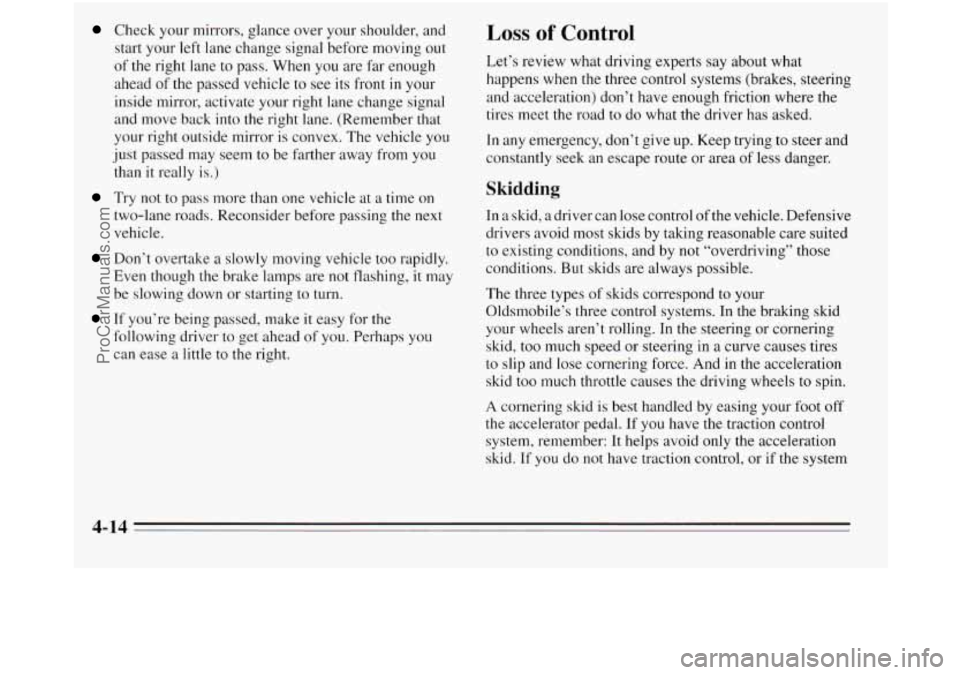
Check your mirrors, glance over your shoulder, and
start your left lane change signal before moving out
of the right lane to pass. When you are far enough
ahead
of the passed vehicle to see its front in your
inside mirror, activate your right lane change signal
and move back into the right lane. (Remember that
your right outside mirror is convex. The vehicle you
just passed may seem to be farther away from you
than it really
is.)
Try not to pass more than one vehicle at a time on
two-lane roads. Reconsider before passing the next
vehicle.
Don’t overtake a slowly moving vehicle too rapidly.
Even though the brake lamps are not flashing, it may
be slowing down or starting to turn.
If you’re being passed, make it easy for the
following driver
to get ahead of you. Perhaps you
can ease a little to the right.
Loss of Control
Let’s review what driving experts say about what
happens when the three control systems (brakes, steering
and acceleration) don’t have enough friction where the
tires meet the road to
do what the driver has asked.
In any emergency, don’t give
up. Keep trying to steer and
constantly seek an escape route or area of less danger.
Skidding
In a skid, a driver can lose control of the vehicle. Defensive
drivers avoid most skids by taking reasonable care suited
to existing conditions, and by not “overdriving” those
conditions. But skids are always possible.
The three types of skids correspond
to your
Oldsmobile’s three control systems. In the braking skid
your wheels aren’t rolling. In the steering or cornering
skid, too much speed or steering in a curve causes tires
to slip and lose cornering force. And in the acceleration
skid too much throttle causes the driving wheels to spin.
A cornering skid is best handled by easing your foot off
the accelerator pedal. If you have the traction control
system, remember: It helps avoid only the acceleration
skid. If
you do not have traction control, or if the system
A 1A
ProCarManuals.com
Page 198 of 390

Here are some tips on night driving.
0
0
0
0
0
0
0
Drive defensively.
Don’t drink and drive.
Adjust your inside rearview mirror to reduce the
glare from headlamps behind you.
Since you can’t see as well, you may need
to slow
down and keep more space between you and other
vehicles.
Slow down, especially on higher speed roads. Your
headlamps can light up only
so much road ahead.
In remote areas, watch for animals.
If you’re tired, pull
off the road in a safe place
and rest.
Night Vision
No one can see as well at night as in the daytime. But as
we get older these differences increase. A 50-year-old
driver may require at least twice as much light to see the
same thing at night as a 20-year-old.
What
you do in the daytime can also affect your night
vision. For example,
if you spend the day in bright
sunshine
you are wise to wear sunglasses. Your eyes will
have less trouble adjusting to night. But if you’re
driving, don’t wear sunglasses at night.
They may cut
down on glare from headlamps, but they also make a lot
of things invisible.
You can be temporarily blinded by approaching lights. It
can take a second or two, or even several seconds, for
your eyes to readjust to the dark. When you are faced
with severe glare (as from a driver who doesn’t lower
the high beams, or a vehicle with misaimed headlamps),
slow down a little. Avoid staring directly into the
approaching lights.
4-16
ProCarManuals.com
Page 201 of 390

poles, or other vehicles, and raindrops “dimple” the
water’s surface, there could be hydroplaning.
Hydroplaning usually happens at higher speeds. There
just isn’t a hard and fast rule about hydroplaning. The
best advice is
to slow down when it is raining.
Some Other Rainy Weather Tips
Turn on your low-beam headlamps -- not just your
parking lamps
-- to help make you more visible to
others.
Besides slowing down, allow some extra following
distance. And be especially careful when you pass
another vehicle. Allow yourself more clear room
ahead, and be prepared to have your view restricted
by road spray.
Have good tires with proper tread depth. (See
“Tires” in the Index.)
City Driving
One of the biggest problems with city streets is the
amount of traffic on them. You’ll want to watch out for
what the other drivers are doing and pay attention
to
traffic signals.
4-19
ProCarManuals.com